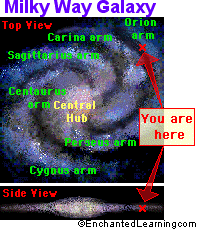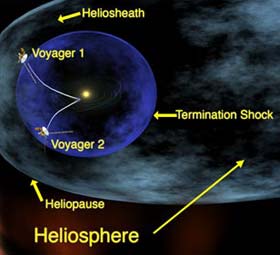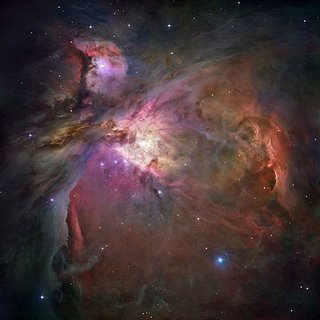Was reading a bit before bed last night. There’s a small article on Voyager 1 and Voyager 2. Nope, it’s not a new movie sequel etc. As most astronomy fans probably know, they are the two spacecrafts launched and funded by NASA in 1977 till now.
Ok, for totally astronomy blur case ppl out there; let me give a bit of intro. Not to say I’m an expert, but I know a bit basic (wic most ppl prob noe) so here we go…
The Earth, and the other 8 planets (Mercury, Venus, Mars, Jupiter, Saturn, Uranus, Neptune & Pluto) circulating the Sun makes up the Solar System. Our solar system is located in the outer reaches of the Milky Way Galaxy, which is a spiral galaxy. The Milky Way Galaxy contains roughly 200 billion stars To give a rough idea of how vast our galaxy is, it takes approximately 100 million million km / 100 000 light years to travel from one end to another. The Milky Way lies within a cluster of galaxies called the Local Group.
Ok, for totally astronomy blur case ppl out there; let me give a bit of intro. Not to say I’m an expert, but I know a bit basic (wic most ppl prob noe) so here we go…
The Earth, and the other 8 planets (Mercury, Venus, Mars, Jupiter, Saturn, Uranus, Neptune & Pluto) circulating the Sun makes up the Solar System. Our solar system is located in the outer reaches of the Milky Way Galaxy, which is a spiral galaxy. The Milky Way Galaxy contains roughly 200 billion stars To give a rough idea of how vast our galaxy is, it takes approximately 100 million million km / 100 000 light years to travel from one end to another. The Milky Way lies within a cluster of galaxies called the Local Group.

The observable universe is believed to contain at least 10 billion (1010) galaxies, clustering together in the thousands but still spaced from one another by millions of light-years.
Talking about astronomy, I vaguely rmr me and the fungus (?) family bk in form 4 or form 5 participated in this national competition on astronomy. Yeah, Baboon gave us the project. Not that he forced us (I think) but the prize was quite attractive; some cash and a telescope! So naturally we accepted it. Yeah, everyone was anticipating the telescope (I know I was). But I guess, students being students, and when something isn’t made compulsory, we never put much effort in it and in the end handed in something we scraped out in a day or two? Hehe, those were the time…
Aniwez, both Voyagers were launched with the initial mission to explore Jupiter and Saturn. After a considerable amt of discovery, they have set to travel further since. They diverged routes (around 1980s) and V1 began to travel outwards of our system (while V2 lingers around planets). V2 is the only spacecraft yet to fly by Uranus and Neptune.
In 2003 or even as early as 2002, V1 is believed to have crossed the termination shock. There were some disagreements but in 2004 the evidence was solid.
However, Stone suggests, the termination shock may have been moving outward from 2002 through 2004 at about the same speed that V1 was traveling.
"We were, in a sense, surfing the shock," he said.
The termination shock is where the solar wind, a stream of electrically charged particles blowing continuously outward from the sun, is slowed by pressure from gas floating between the stars. It can expand, contract, and ripple, depending on changes in the speed and pressure of the solar wind.
Voyager 1 is now 94 astronomical units from the sun. (One astronomical unit equals the distance between the Earth and the sun.)
Now Voyager 1 has entered uncharted territory: the heliosheath. The sheath also marks the transition between our solar system and the interstellar medium.

Scientists don't know exactly how wide the heliosheath is, but they expect that it will take Voyager 1 another 10 years or so to travel through the region. The spacecraft is expected to keep going until it runs out of power, probably around 2020 at the earliest.
After traveling through the heliosheath, Voyager 1 will encounter the heliopause, a boundary region that may be as complicated as the termination shock. This is where the wind from our sun mixes with interstellar wind.
"Once it crosses the heliopause, Voyager will be the first human-made object to reach interstellar space," Stone said. "Once there, we can determine for the first time the strength of the interstellar magnetic field."
V2 is expected to cross the termination shock between the period 2007 to 2010. The Voyagers contain the records of Earth's life and sounds, gifts for any intelligent being out there yet to be discovered.
Oh, another interesting read from National Geographic magazine, is human may have discovered the 4th state of matter. We lived thus far knowing gas, liquid and solid but that’s not it, or so they said. SO have a quick guess? Well, I never guessed it, but the answer is plasma.
The earth is surrounded by it. The aurora borealis is a lovely example of it. So is lightning. The sun is made of it. Plasma is a gas in which atoms have been ionized – that is to say, stripped of electrons. Because of that, plasma has magnetic and electric fields that move around rambunctiously and unpredictably, altering their environment. As the environment changes so does the plasma – a continuous dance of action and reaction. It’s usually hot but can also be cold. “Plasma as a life of its own” says Walter Gekelman, who researches the stuff in an enormous basement laboratory at UCLA.


Orion Nebula in Billion-Pixel Beauty
Credits:
http://www.setileague.org/reviews/aliens.htm
http://voyager.jpl.nasa.gov/mission/didyouknow.html
No comments:
Post a Comment